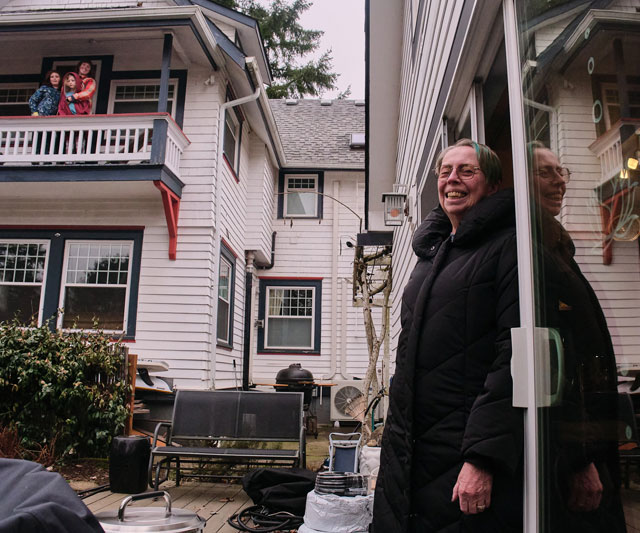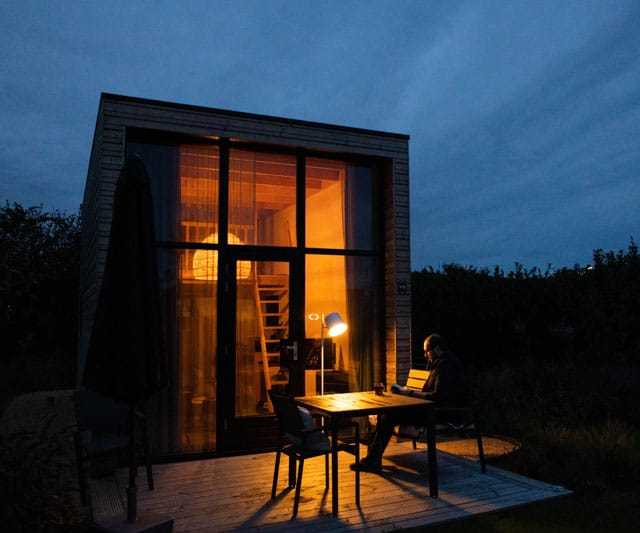Forty-five years ago, Betty Szudy and her wife, Maggie Roth, both 70, bought a Craftsman bungalow in Oakland, California. In 2017, at the same time their son and his wife were fruitlessly searching for an affordable apartment in the neighborhood, California was liberalizing its housing laws to encourage so-called accessory dwelling units, or ADUs.
So, the family looked into building one. The parents now live in the main house and the adult children in the ADU — in this case, a once-decrepit garage transformed into a 400-square-foot studio with a kitchen and bath.
The arrangement makes it simple to share meals, planned or spontaneous, and to pick up items for the other household at Trader Joe’s. “I love having them around,” Szudy said.
“It made total sense,” she said. “The idea of having a family compound, being close but having separate spaces.”
In Portland, Oregon, on the other hand, it’s the younger family — Jules Radkin and Pia da Silva, their two children and a dog — who occupy the primary four-bedroom house. Da Silva’s parents moved into the ADU, a 740-square-foot, two-bedroom structure also converted from a garage.
Vona da Silva and her husband, Richard Silva, da Silva’s parents, had been planning to age in place in a downtown condo. But with their daughter’s expanding family outgrowing their small house, the older couple sold their condo. In 2014, they bought the property both families now share, designing and building their backyard ADU with plenty of grab bars. Since Silva died last year at 83, Vona da Silva, 80, has lived there alone.
“It absolutely exceeded all our expectations,” she said of the arrangement. With the children so close, “if they need child care, I pitch in. If I need care in the future, they will pitch in. They are prepared to be caregivers.”
Accessory dwelling units — also known as in-law suites, granny flats, casitas or guest cottages — come in many forms. They can be free-standing or attached to the main house on the property they share; they can be apartments in basements or atop garages. An ADU, which is typically 600 to 1,000 square feet, has a bathroom, a kitchen or kitchenette, and, usually, a separate entrance.
Its function can change over the decades. A rental that generates income for young homeowners might later become a refuge for returning young adults, then become a way for older homeowners to defray housing costs and remain in their neighborhoods.
In an aging nation, an ADU makes particular sense for people in their 60s and up who don’t want to move and will need nearby caregivers, either family members or hired aides. Silva died at home of pulmonary fibrosis, and in his final weeks and months, his daughter and son-in-law had to walk only a few yards to help care for him.
“They came over and did whatever needed to be done,” Vona da Silva said. With such proximity, “everybody has to be respectful,” she acknowledged. “But for us, it’s been wonderful.”
As affordable housing grows increasingly scarce for both young and old, ADUs provide several advantages. “They create housing that doesn’t alter the look or feel of a community,” said Zoe Baldwin, the New Jersey director of the Regional Plan Association, a nonprofit group in the Northeast.
“It’s a way to add capacity within the existing footprint,” she said, a strategy planners sometimes call “gentle density.” ADUs don’t require much government investment in infrastructure, and they reduce energy consumption and costs.
Accordingly, they are growing more popular. Ten states and the District of Columbia, as well as many municipalities, have adopted or revised laws to encourage ADU construction, reducing barriers like zoning, parking restrictions and onerous approval processes.
In California, which has passed a series of laws enabling the use of ADUs, permits rose to nearly 20,000 in 2021 from about 1,200 in 2016, the year before the first law took effect, the state has reported.
AARP, which supports ADUs, has helped 17 cities pass such legislation in the past two years, among them Pittsburgh; Denver; Louisville, Kentucky; Raleigh, North Carolina; and Kansas City, Missouri. “It’s encouraging to see the numbers growing,” said Rodney Harrell, the organization’s housing expert.
By analyzing real estate listings, Freddie Mac, the federally chartered housing finance company, estimated in 2020 that the United States had 1.4 million legal ADUs, half of them in California, Florida, Texas and Georgia. Between 2009 and 2019, sales listings of houses with ADUs rose an average 8.6% annually, the company found.
Further growth is “just inevitable,” said Harold Simon, the retired editor of community development magazine Shelterforce. “1.4 million units is not a fad.” He helped draft one of three accessory unit bills now working their way through the New Jersey Legislature.
Still, accessory units face suspicion and opposition from some quarters. Single-family zoning, widely used since the 1950s to control development, but also to maintain racial and economic exclusion, is often “sacrosanct, the 11th commandment,” Simon said. About 80% of the nation’s neighborhoods permit only single-family homes, AARP has found.
Besides, “towns don’t like being told what to do,” said Melissa Kaplan-Macey, director of the Regional Plan Association in Connecticut, which helped enact statewide ADU legislation in 2021. To pass the bill, supporters included a provision allowing municipalities to opt out, and a number have. Some towns are adopting their own ADU laws, and others are continuing to bar ADUs altogether.
In some locations, laws ostensibly enabling accessory units create so many restrictions — including parking and owner-occupancy requirements — that they actually discourage construction.
“ADUs should be treated similarly to other forms of housing, to the single-family house next door,” Harrell said.
Creating these units can be dauntingly expensive. A Berkeley, California, study in 2021 found that median construction costs in California were $150,000, and even higher in the Bay Area, for an average 615-square-foot unit.
Szudy and Roth refinanced their primary house to spend between $150,000 and $200,000 building their backyard studio in Oakland.
“The financing is the next big frontier,” Kaplan-Macey said. ADU proponents will have to work with lenders, manufacturers and property tax authorities to make the option affordable for homeowners with more modest incomes.
But the idea is clearly catching on. In Bend, Oregon, Julie and Paul Anderson built a contemporary-style house four years ago and added an attached one-bedroom apartment. Her parents have spent four months there each summer, escaping the heat in Tucson, Arizona, where they live; a tenant rents it the rest of the year.
Anderson and her husband have considered moving into the ground-floor ADU when they retire and renting out the larger space upstairs to supplement their income. But the needs of their parents, all in their 70s and 80s, take precedence for now.
“We have peace of mind,” Anderson said, “knowing that if an older family member needs care, we have this space.”
c.2023 The New York Times Company. This article originally appeared in The New York Times.







